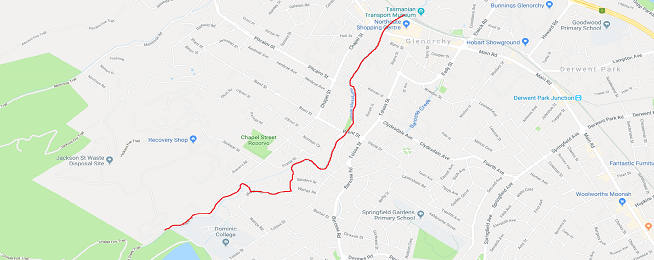The top end of Glenorchy’s Tolosa Street has become increasingly busy with the success of the Glenorchy Mountain Bike Park, Tolosa Park criterium cycling circuit and mountain bike trails in Wellington Park.
Combined with the two schools in the area, the narrow suburban street is carrying more and more people.
The Glenorchy City Council is asking for ideas to redevelop Tolosa Park once the TasWater dam there is decommissioned.
Bicycle Network has provided feedback to the council that it needs to consider how people get to Tolosa Park as part of any redevelopment. As the Tolosa Park area has become a destination for road and mountain bike riders of a wide range of ages, it would benefit current and future users to make it easier to ride there.
Separated path
Tolosa Street has little space for protected bicycle lanes and the roundabout crossings pose dangers for people riding. The alternative street access is Chapel Street but as that is used by heavy vehicles going to the tip, it would not be suitable for most of its length.
Instead, a protected cycling path could be built that follows the Humphreys Rivulet, joining the city centre and Intercity Cycleway to Tolosa Park.
An off-road, protected cycleway would be ideal to get people to Tolosa Park as it would also service the two schools in the area and residents wanting to ride to the city centre or use the Intercity Cycleway to commute between Hobart.
The idea for a rivulet path was first floated in 1977 but more recently in 2012 Pitt and Sherry undertook a concept development review into a shared cycling and walking path for Glenorchy city Council, prompted by Cycling South and Bicycle Network. This covered the distance from the Intercity Cycleway through to the end of Chapel Street (which would need a bridge over the rivulet to link with Tolosa Park).
Off-road and on-road
The concept review proposes a break in the protected cycleway between Brenock Court and Maitland Street, taking riders on to residential roads for a short distance before the path along the rivulet starts up again. This was suggested because the rivulet is narrow in this section and would require substantial engineering works to continue the path.
If the council decided to take this option, rather than continuing the route along the rivulet, it needs to be accompanied with other traffic-calming measures to ensure a wide range of riders felt safe on that section on road.
The benefit of protected cycleways is that they attract many more people to ride. Research from the US city of Portland estimated that up to 60% of the population would ride more often if they had access to protected cycleways. These people enjoy riding and want to ride more often but will not attempt to if they feel they are at risk of being hit by a vehicle.
Residential street cycleways have attracted safety conscious riders in Portland but only because they have used streets with low traffic volumes and been accompanied by extensive traffic calming measures.
Measures that may help riders to feel safer include:
- 30km/h speed limit
- obvious street signage directing bicycle riders to destinations, including distances
- on-road lanes or sharrows to show the position a rider should take on the ride to be out of the reach of parked car doors opening
- traffic calming measures in the streets which don’t already have them, such as speed humps, car lane narrowing, street plantings and footpath widening.
- Roads where cars can’t continue but bicycles can
- priority crossings for bicycles leading into and from the cycleway streets, including median crossing islands for riders.
Because there is a danger that an on-road section of a cycleway may deter some people from using the path, a formal evaluation should be conducted of the use of the streets to gauge whether riders still feel comfortable once they go off the path and on to the road.
If riders don’t feel safe, then the council would need to consider what engineering solutions could be employed to complete the path along the rivulet.
You can provide feedback on the Tolosa Park redevelopment until 20 April 2018.


